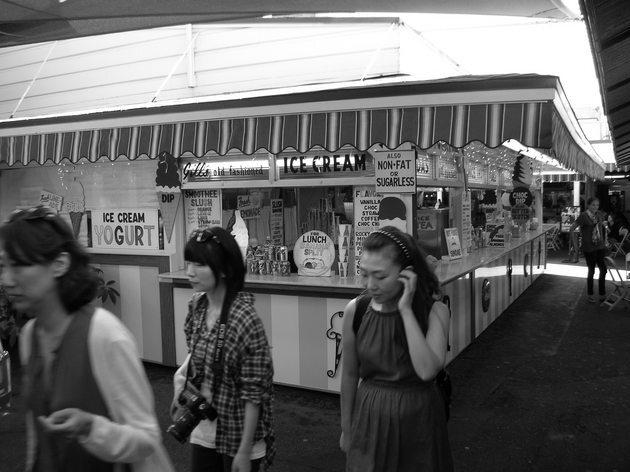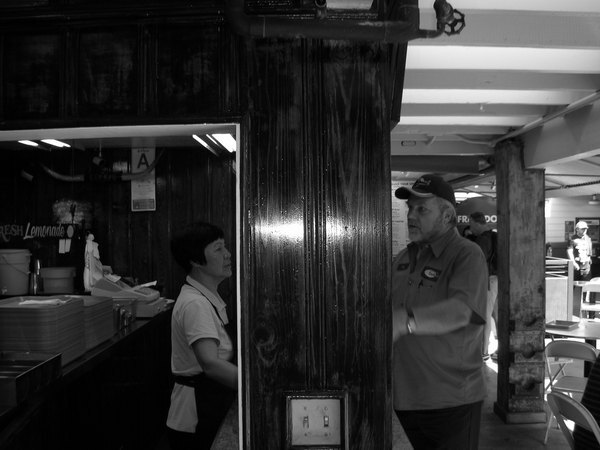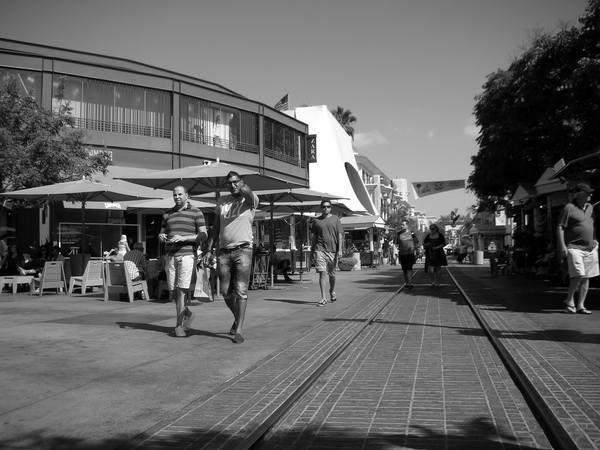A Los Angeles Primer: the Original Farmers Market

We must make peace with the fact that some people arrive in Los Angeles expecting to spot celebrities. Nine times out of ten, though, they board the plane home disappointed; this city fosters a secretive, detached celebrity culture, the uppermost sector of which somehow walls itself off completely from open society. Public figures of slightly less renown make their way through Los Angeles as any other resident would, but this everyday conspicuousness renders them, in many cases, inconspicuous; I sense they take pains to avoid places "celebrities would go." Visitors from other states, other countries, and other continents alike, thus roam the likes of Hollywood Boulevard and the Sunset Strip in vain, encountering only the occasional reality television star, a class of performer whose very existence owes to their readiness for the spotlight. If you wish to bask in the aura of proper celebrities — the kind who don't want you to notice them — go somewhere like the Farmers Market, which for nearly eighty years now, at the corner of Third Street and Fairfax Avenue, has offered a collection of produce dealers, food stalls, larger eateries, coffee shops, and souvenir stands.
Perhaps this already sounds like a tourist trap, and I haven't yet mentioned its abundance of palm tree-filled postcards and its vintage gas pump, enshrined and gleaming just as it must have back when the Gilmore Oil Company kept a functioning station there. Yet the whole operation has, over time, settled into the kind of hybrid appeal enjoyed by Seattle's Pike Place Market (the kind that has, in recent decades, eluded San Francisco's Fisherman's Wharf): it draws locals and outsiders in seemingly equal measure, inspiring in them seemingly equal enthusiasm. Seated at one of the many tables scattered around the Farmers Market, practicing the ancient art of people-watching, I've seen day-long waves of obvious regulars making beelines for long-preferred seats, politics-arguing old-timers, Los Angeles-unsavvy new arrivals wondering if they've stumbled upon the city's center, hungry employees of nearby CBS Televison City, and foreign nationals with cameras in hand. One day at the Farmers Market, two such tourists, young girls from Japan, approached me very slowly. "Take a picture with me?" one asked, gesturing toward her friend who stood ready to capture an image of her traveling companion and this specimen of the elusive Homo americanus.

I sat for the photo, but then proceeded to tarnish the purity of their experience by speaking Japanese; I only let a few sentences out, but the pair didn't exactly react with delight. Nevertheless, I believe they got more or less what they came for, as would an assiduous enough visitor out for a glimpse of faces known from the screen. The mildly privacy-minded celebrity, feeling the urge for a crêpe, a plate of Singaporean food, a wedge of imported cheese, a jar of hot sauce, or some combination thereof, prefers to indulge it at the Farmers Market, which offers an open-air environment even as its status as private property makes business tricky for the paparazzi. When traveling myself, I find the sort of encounters that leave me photographed as a curiosity, practiced English upon, or interviewed for school projects, happen without exception in large, usually iconic, public spaces: the park surrounding Osaka Castle, for instance, or Mexico City's Zócalo. In Los Angeles, where private property can succeed by simulating public property, things work differently. This city has long endured a complicated, often troubled relationship with its public spaces — even with the theoretical concept of public spaces — which I get the impression that the average Angeleno of the past half-century has experienced primarily through the surfaces of the freeways. The title of Los Angeles observer Charles Moore's book You Have to Pay for the Public Life says it all.
"The most evident thing about Los Angeles," Moore writes in a 1965 essay, "is that in the terms of any of the traditions we have inherited, hardly anybody gives anything to the public realm. Instead it is not at all clear what the public realm consists of, or even for the time being, who needs it." He goes on to describe how Disneyland, that much-celebrated piece of Orange County private property neglected by few if any tourists, has, in its way, replicated and indeed supplanted "many of those elements of the public realm which have vanished in the featureless private floating world of southern California." But the price of a ticket to Disneyland's pseudo-public life has, since the mid-sixties, risen to, depending on the day you choose to go, either imposing heights or ludicrous heights. Participation in that of the Farmers Market demands only the cost of presence-justifying (or parking-validating) cup of coffee. Despite the straightforwardness of the Farmers Market experience, though, the place has a few Disneyland-ish qualities of its own which, even past that gas pump, can make it come off like a theme park commemorating allegedly simpler times. Scanning across my lunch options, I see simple color schemes, chalkboard menus, uniformed attendants in visors and aprons leaning against counters — we might as well have returned to the 1940s.

Yet these attractions draw a crowd that, standing in unquestionable contrast, represents, as well as any sample can represent, the Los Angeles of the 21st century. For all the self-awareness worked up about its role as a landmark since its official designation as a Los Angeles Historic-Cultural Monument came through in 1991, the Farmers Market remains cool, or at the very least not uncool, to enjoy. But this goes only for its innermost section, whose basic form, judging by all the historic photos hung up around it, has hardly changed in the past half-century. The core of the Farmers Market may have weathered periodic threats of replacement with condos, office towers, or a more conventional mall, but its immediate surroundings don't command quite the same respect. I refer, as habitués will have guessed, to the Grove, the outdoor shopping complex opened by well-known developer Rick Caruso behind the Farmers Market in 2002, complete with an elaborate fountain and a short length of trolley track. Apparently geared toward upper-middle-class young teenagers on dates — browsing at Forever 21 and J. Crew, dinner at the Cheesecake Factory, movie at the fourteen-screen multiplex — the Grove practically welcomes all the scorn we spare its much older plot-mate.
The first time I had to cross the Grove's threshold, I realized I'd found a neat local illustration of the difficult-to-translate Russian term poshlost, whose admittedly dramatic partial definitions include "self-satisfied vulgarity" (from Vladimir Alexandrov's study of Nabokov) to "the complacent mediocrity and moral degeneration of [the] environment" (from Thais Lindstrom's history of Russian literature) to "corny trash, vulgar clichés, Philistinism in all its phases, imitations of imitations" (from Nabokov himself). Yet I really do need to go there more often that I've ever had practical reason to go the Farmers Market: for a gift off a wedding registry, a new keyboard, a pair of shoes. Despite its excesses, Caruso's signature Fairfax District project delivers a kind of counterintuitive utilitarian value. And even its aesthetic has its champions: Yubin Kim, of the Korean singing group Wonder Girls, named it her favorite place in Los Angeles on the strength of its beauty alone. If your celebrity interests lay with foreign pop stars, then, you may find the Farmers Market wanting, but to fulfill them, you need only walk a few yards to the northeast.
Photos by Colin Marshall.